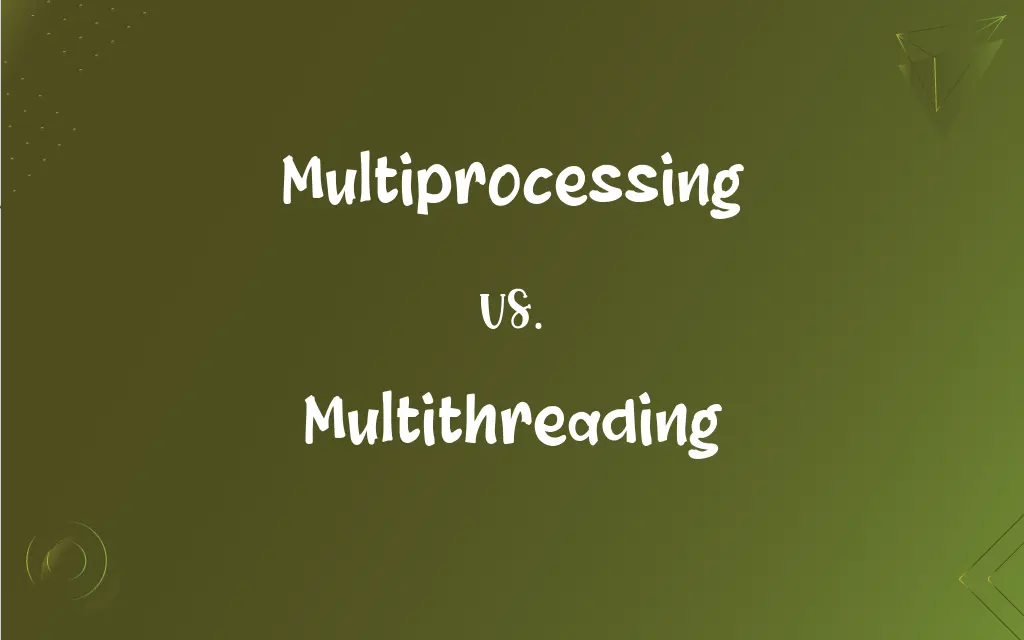Multiprocessing vs. Multithreading: What's the Difference?
Edited by Aimie Carlson || By Janet White || Published on February 25, 2024
Multiprocessing involves multiple processors running processes simultaneously for parallel execution, while multithreading involves a single process dividing its tasks into multiple threads for concurrent execution.

Key Differences
Multiprocessing is a technique where multiple processors execute different processes simultaneously, enhancing performance and speed in computing tasks. In contrast, multithreading involves splitting a single process into multiple threads that run concurrently, allowing more efficient use of CPU resources. Both multiprocessing and multithreading improve the efficiency and speed of computational tasks, but they do so in fundamentally different ways.
In multiprocessing, each processor operates independently with its memory space, preventing memory sharing conflicts but increasing the complexity of data synchronization. Multithreading, however, allows threads within the same process to share memory space, facilitating communication but increasing the risk of data conflicts. Both methodologies require careful management to optimize performance and maintain data integrity.
Multiprocessing is particularly beneficial in tasks requiring heavy computational power or parallel processing, as it can significantly reduce processing time. Multithreading is advantageous in applications where tasks can be broken down into smaller, concurrent operations, improving responsiveness. Each approach is selected based on the specific requirements and nature of the computing task at hand.
Multiprocessing systems are generally more robust and stable since the failure of one processor does not necessarily impact the others. In contrast, multithreading can introduce complexities related to thread management and synchronization, potentially affecting stability. Both approaches, however, greatly enhance computational capabilities when appropriately utilized.
The choice between multiprocessing and multithreading often depends on the application's requirements, with multiprocessing being ideal for compute-intensive tasks and multithreading for tasks requiring responsiveness and quick context switching. Both are critical in modern computing, offering different strategies to improve performance and efficiency.
ADVERTISEMENT
Comparison Chart
Process Execution
Involves multiple processors running processes
Involves dividing a single process into threads
Memory Usage
Separate memory for each process
Shared memory space within the process
Use Cases
Ideal for compute-intensive parallel tasks
Suitable for tasks requiring responsiveness
Performance Impact
Reduces processing time, enhances parallelism
Improves CPU utilization, responsiveness
Stability and Complexity
More robust but complex synchronization
Risks with thread management and stability
ADVERTISEMENT
Multiprocessing and Multithreading Definitions
Multiprocessing
Multiprocessing uses multiple processors for parallel task execution.
The server's multiprocessing capability allowed it to handle multiple large-scale computations simultaneously.
Multithreading
Multithreading improves responsiveness and CPU utilization.
Through multithreading, the application remained responsive while performing background tasks.
Multiprocessing
Multiprocessing enhances computing power and speed.
For the data analysis task, multiprocessing significantly reduced the overall processing time.
Multithreading
Threads in multithreading share the same memory space.
Multithreading allowed different parts of the program to share information quickly and efficiently.
Multiprocessing
Each processor in multiprocessing operates independently.
Multiprocessing enabled each application to run on a separate processor, ensuring smooth performance.
Multithreading
Multithreading is suitable for tasks requiring quick context switches.
The video game used multithreading to seamlessly manage user inputs and game physics.
Multiprocessing
Multiprocessing avoids performance bottlenecks in heavy tasks.
To prevent bottlenecks during peak hours, the system used multiprocessing strategies.
Multithreading
Multithreading divides a process into several concurrent threads.
The web server used multithreading to handle multiple user requests at the same time.
Multiprocessing
Multiprocessing is ideal for compute-intensive tasks.
The scientific simulations used multiprocessing to efficiently process complex calculations.
Multithreading
Multithreading can lead to complexities in synchronization.
To avoid issues, the developers implemented careful thread synchronization in their multithreading model.
Multiprocessing
A method of computing in which different parts of a task are distributed between two or more similar central processing units, allowing the computer to complete operations more quickly and to handle larger, more complex procedures.
Multithreading
(computing) The use of multithreaded code.
Multiprocessing
Computation using more than one processor.
Multiprocessing
Simultaneous processing by two or more processing units
FAQs
How does multiprocessing enhance performance?
Multiprocessing enhances performance by parallelizing tasks across multiple processors.
How does multithreading improve CPU utilization?
Multithreading improves CPU utilization by allowing concurrent execution of threads within a process.
Is multiprocessing suitable for small-scale applications?
Multiprocessing is generally more suited for large-scale, compute-intensive applications.
What is multiprocessing?
Multiprocessing is the use of multiple processors for executing several processes simultaneously.
Do multiprocessing systems require more memory?
Yes, multiprocessing systems often require more memory due to separate memory spaces for each process.
How do threads in multithreading communicate?
Threads in multithreading communicate through shared memory within the same process.
What is multithreading?
Multithreading is the technique of dividing a single process into multiple threads for concurrent execution.
What are the risks associated with multithreading?
The primary risks with multithreading involve thread synchronization and potential deadlocks.
What is the main challenge in multiprocessing?
The main challenge in multiprocessing is the complexity of data synchronization between processes.
Can multiprocessing and multithreading be used together?
Yes, both techniques can be combined for optimized performance in complex systems.
How does multiprocessing affect system stability?
Multiprocessing can enhance system stability as processes operate independently.
Can multithreading be used in single-processor systems?
Yes, multithreading can be effectively used in single-processor systems to improve responsiveness.
How does multiprocessing handle processor failure?
In multiprocessing, the failure of one processor does not necessarily affect the others.
Does multithreading require special programming techniques?
Yes, multithreading requires careful programming to handle thread creation, synchronization, and management.
What type of applications benefit most from multiprocessing?
Applications that require parallel processing, like scientific simulations, benefit most from multiprocessing.
Is multithreading beneficial in user interface applications?
Yes, multithreading is beneficial in UI applications for maintaining responsiveness.
What programming languages support multithreading?
Many programming languages, including Java, C++, and Python, support multithreading.
Are there specific operating systems better suited for multiprocessing?
Operating systems with advanced process management features, like UNIX and Linux, are well-suited for multiprocessing.
Are multiprocessing systems more expensive than single-processor systems?
Generally, multiprocessing systems are more expensive due to the need for multiple processors.
Can multithreading lead to faster task completion?
Multithreading can lead to faster completion of tasks that are broken down into concurrent threads.
About Author
Written by
Janet WhiteJanet White has been an esteemed writer and blogger for Difference Wiki. Holding a Master's degree in Science and Medical Journalism from the prestigious Boston University, she has consistently demonstrated her expertise and passion for her field. When she's not immersed in her work, Janet relishes her time exercising, delving into a good book, and cherishing moments with friends and family.
Edited by
Aimie CarlsonAimie Carlson, holding a master's degree in English literature, is a fervent English language enthusiast. She lends her writing talents to Difference Wiki, a prominent website that specializes in comparisons, offering readers insightful analyses that both captivate and inform.







































































